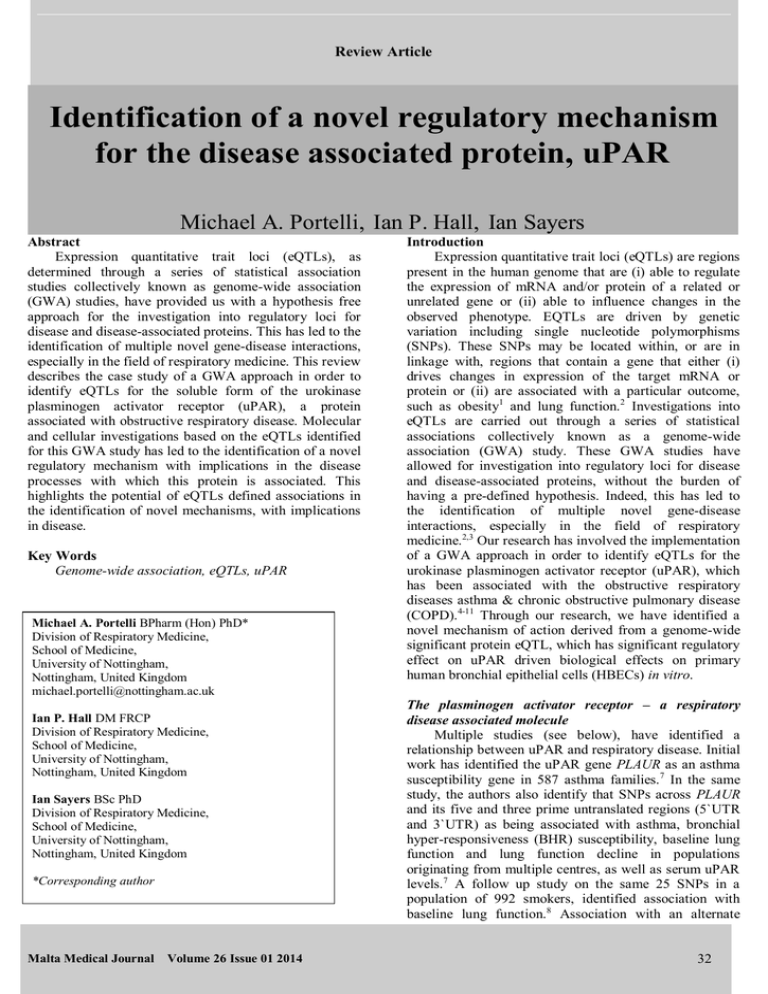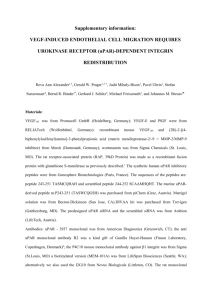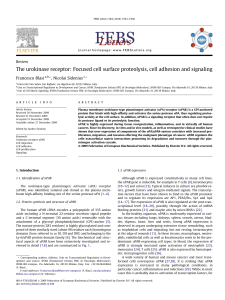Review Article
advertisement

Review Article Identification of a novel regulatory mechanism for the disease associated protein, uPAR Michael A. Portelli, Ian P. Hall, Ian Sayers Abstract Expression quantitative trait loci (eQTLs), as determined through a series of statistical association studies collectively known as genome-wide association (GWA) studies, have provided us with a hypothesis free approach for the investigation into regulatory loci for disease and disease-associated proteins. This has led to the identification of multiple novel gene-disease interactions, especially in the field of respiratory medicine. This review describes the case study of a GWA approach in order to identify eQTLs for the soluble form of the urokinase plasminogen activator receptor (uPAR), a protein associated with obstructive respiratory disease. Molecular and cellular investigations based on the eQTLs identified for this GWA study has led to the identification of a novel regulatory mechanism with implications in the disease processes with which this protein is associated. This highlights the potential of eQTLs defined associations in the identification of novel mechanisms, with implications in disease. Key Words Genome-wide association, eQTLs, uPAR Michael A. Portelli BPharm (Hon) PhD* Division of Respiratory Medicine, School of Medicine, University of Nottingham, Nottingham, United Kingdom michael.portelli@nottingham.ac.uk Ian P. Hall DM FRCP Division of Respiratory Medicine, School of Medicine, University of Nottingham, Nottingham, United Kingdom Ian Sayers BSc PhD Division of Respiratory Medicine, School of Medicine, University of Nottingham, Nottingham, United Kingdom *Corresponding author Malta Medical Journal Volume 26 Issue 01 2014 Introduction Expression quantitative trait loci (eQTLs) are regions present in the human genome that are (i) able to regulate the expression of mRNA and/or protein of a related or unrelated gene or (ii) able to influence changes in the observed phenotype. EQTLs are driven by genetic variation including single nucleotide polymorphisms (SNPs). These SNPs may be located within, or are in linkage with, regions that contain a gene that either (i) drives changes in expression of the target mRNA or protein or (ii) are associated with a particular outcome, such as obesity1 and lung function.2 Investigations into eQTLs are carried out through a series of statistical associations collectively known as a genome-wide association (GWA) study. These GWA studies have allowed for investigation into regulatory loci for disease and disease-associated proteins, without the burden of having a pre-defined hypothesis. Indeed, this has led to the identification of multiple novel gene-disease interactions, especially in the field of respiratory medicine.2,3 Our research has involved the implementation of a GWA approach in order to identify eQTLs for the urokinase plasminogen activator receptor (uPAR), which has been associated with the obstructive respiratory diseases asthma & chronic obstructive pulmonary disease (COPD).4-11 Through our research, we have identified a novel mechanism of action derived from a genome-wide significant protein eQTL, which has significant regulatory effect on uPAR driven biological effects on primary human bronchial epithelial cells (HBECs) in vitro. The plasminogen activator receptor – a respiratory disease associated molecule Multiple studies (see below), have identified a relationship between uPAR and respiratory disease. Initial work has identified the uPAR gene PLAUR as an asthma susceptibility gene in 587 asthma families. 7 In the same study, the authors also identify that SNPs across PLAUR and its five and three prime untranslated regions (5`UTR and 3`UTR) as being associated with asthma, bronchial hyper-responsiveness (BHR) susceptibility, baseline lung function and lung function decline in populations originating from multiple centres, as well as serum uPAR levels.7 A follow up study on the same 25 SNPs in a population of 992 smokers, identified association with baseline lung function.8 Association with an alternate 32 Review Article obstructive lung disease, i.e. COPD, was determined in an independent study, where through gene expression profiling and lung function studies in 43 COPD subjects, PLAUR was determined to be differentially expressed in the COPD lung when compared to controls. 6 Interestingly, the association of PLAUR with COPD was found to be independent of the smoking pack/year status. 6 Our own study has identified a strong association between circulating uPAR levels and obstructive lung disease. A further two studies identify elevated soluble cleaved uPAR (scuPAR) levels in the induced sputum of asthmatic and COPD patients4, 5, with levels associated with airflow limitation, health status and exercise tolerance in COPD patients.4 Levels of circulating scuPAR were also found to be correlated with lung function in a separate study. 7 This suggests that identified uPAR dependant effects may be at least partially driven by the soluble cleaved form of the receptor, a situation previously hypothesised in a human bronchial epithelial cell population.9 Further evidence for the role of uPAR in obstructive lung disease has been published in a number of in vitro and ex vivo studies as described below. While membrane bound uPAR has been shown to be standardly expressed in the apical membrane of the airway epithelium12, levels were elevated in the inflamed asthmatic epithelium when compared to healthy controls9,13 and in COPD subjects when compared to controls.6 uPAR was also elevated in the lungs of patients who died of status asthmaticus, when these were compared to the airways obtained from 7 lung donors with no prior diagnosis of asthma. 14 In an in vitro study using normal HBECs, mechanical stimulation of cells in order to mimic the process that occurs in the lung during bronchoconstriction, an important event in both asthma and COPD, resulted in a 16.2 fold increase in the expression of PLAUR mRNA in conjunction with the elevation of other molecules involved in the fibrinolytic pathway, such as the uPAR ligand urokinase (uPA) and its inhibitor the plasminogen inhibitor type 1 (PAI-1).14 A more recent study has also identified a role for the receptor in the epithelial-mesenchymal transition of bronchial epithelial cells.15 Here data suggests that a uPAR-dependent signaling pathway is required for EMT induced through exposure of cigarette smoke, contributing to small airway fibrosis occurring in COPD. 15 Globally, this evidence suggests that uPAR may be involved in asthma and COPD pathogenesis, where elevated receptor levels could cause changes in the airways synonymous with both asthma and COPD, a hypothesis supported by a study which identifies uPAR as a potential marker of airway disease severity.16 Direct roles for uPAR in obstructive respiratory disease has in fact been suggested, where uPAR is Malta Medical Journal Volume 26 Issue 01 2014 identified as being involved in lung tissue remodelling and repair in COPD subjects. This hypothesis that uPAR is involved in asthma and COPD pathophysiology through a direct role in airway remodelling, is further supported by a number of other studies.17-19 In the first instance, elevated levels of uPA and PAI-1 in the airways post injury17, suggest involvement of uPAR in airway disease. Involvement of uPAR in airway disease was confirmed through the concomitant discovery that uPAR is not only critical for efficient bronchial wound repair in vitro, but that in vivo, inhalation of uPA protects against subepithelial fibrosis and airway hyper-responsiveness in an asthma mouse model.18 Together, these data suggest that the uPAR pathway is likely important in airway injury. Indeed, a recent study has confirmed the role of uPAR in airway injury in uPAR-deficient mice, where the knockout mice spontaneously developed airway fibrosis. 19 Airway injury and the deregulation of repair are prevalent in asthma and COPD and are known to have a role in airway remodelling during disease development. Structure of the urokinase plasminogen activator receptor The plasminogen activator receptor is a three homologous domained protein20, where each domain (annotated as DI, DII and DIII respectively) is separated by a 15 residue inter-domain linker sequence and which is attached to the outer leaflet of the phospholipid bilayer of the cellular membrane via a glycosylphosphatidylinositol (GPI) anchor.13, 21-23 uPAR is encoded for by a gene located on chromosome 19q13 and is present on the antisense strand of the human genome. 20 The PLAUR gene in its full form consists of 7 exons; of these, exon 1 encodes the 5`UTR and a signal peptide, while exons 2-3, 4-5 and 6-7 respectively encode the homologous protein domains DI, DII and DIII.20 (see Fig. 1.) The GPI anchor, which attaches the receptor to the cellular phospholipid bilayer, is susceptible to glycolytic and lipolytic cleavage, most significantly by the enzymes phospholipase C and D.25, 26 This results in the release of the entire protein moiety from the cell surface forming scuPAR (Fig. 2). This soluble moiety has been detected in the periphery (serum levels) and has been shown to be elevated in asthmatic patients when compared to nonrespiratory disease controls and in COPD patients when compared to asthmatics and non-respiratory disease controls, with elevated levels also identified in the induced sputum of these patients. 11 The scuPAR has also been identified to have a direct role in the modulation of disease, specifically in focal segmental glomerulosclerosis, which leads to proteinuric kidney disease, where scuPAR is directly involved in disease development through activation of the podocyte β(3) integrin.27 33 Review Article Figure 1: Gene structure for the PLAUR gene. PLAUR is located on chromosome 19q13 and in its full form consists of 7 exons when code for the full-length membrane-bound protein uPAR, Exon 1 encodes for the gene’s 5`UTR and a signal peptide, while the exon pairs 2&3, 4&5 and 6&7 each code for the receptors three homologous domains, known as DI, DII and DIII. This gene has been identified to be expressed in the lung, in human airway smooth muscle cells and in human bronchial epithelial cells 24. Other splice variants exist in either form, namely Exon 3, Exons 4 & 5, Exon 5 and Exon 6 deletions and an alternate exon 7(b) located at a further distal region and encoding for an alternate DIII and 3`UTR. Figure 2: PLAUR cleavage products. PLAUR is a 3 globular domain protein attached to the cellular membrane via a GPI anchor. Cleavage occurring on the membrane bound receptor can either be proteolytic or glyco/lipolytic. Glycolytic and lipolytic cleavage occurs at the GPI anchor by substances such as Phospholipase C & D, and results in the formation of a soluble form of the receptor which structurally mirrors the corresponding membrane bound receptor. Proteolytic cleavage occurs in the linker region between DI and DII and results in the loss of DI to form a DII/DIII fragment which has chemotactic activity. Malta Medical Journal Volume 26 Issue 01 2014 34 Review Article Genome-wide association identifies a novel regulatory region for scuPAR As part of our interest into uPAR and its role in obstructive lung disease, we were concerned about the regulation of circulating scuPAR. A 2009 genetics study had identified a link between uPAR polymorphisms associated with lung function and serum scuPAR levels, suggesting a link between the soluble molecule and respiratory disease. A better understanding of the regulatory mechanism of scuPAR would therefore theoretically allow for a more complete understanding of how this molecule regulates and is associated with disease. Also further determination of scuPAR regulation would provide potential novel therapeutic targets for scuPAR regulation. Using a hypothesis-free approach, i.e. a GWA study, we investigated eQTLs driving scuPAR levels in the serum of asthma patients and non-respiratory disease controls investigating a total of 295,196 SNPs.11 This study identified a locus of interest at location 4q35 containing associations for SNPs rs4253238 and rs1912826 in a combined dataset of the control and asthma patient serum samples (n=584, λ=1.009), which achieved genome-wide significance as defined by the Bonferroni method (p<1.69x10-7).11 These SNPs were found to be in near complete linkage disequilibrium (LD) (D´=0.99; R2=0.94) in the study population and so were considered as a single region of variation. The location of this region of association was identified to lie in the promoter/5’ coding region of the gene for human plasma kallikrein (KLKB1; previously known as KLK3). Confirmation of the association in a secondary genotyped in a COPD cohort (n=219), further defined this region as an eQTL for serum scuPAR levels (p=5.34x10-7; B=0.16812 for log10-transformed uPAR levels and additive allele coding) 11, as did a metaanalysis including all three populations (n=803) (p=5.037x10-12; B=0.0879).11 Molecular Biology techniques confirm a GWA identified eQTL Although multiple GWA studies have been published over the past few years since the first publication identified in a PubMed search using the target word ‘GWAS’28, with a large number of publications with the target word ‘GWAS’ being identified in the past few years (Fig. 3), very few studies have investigated in detail the mechanism driving the genetic association(s) described. Figure 3: Publications listed on Pubmed returning when queried with the word ‘GWAS’. Results identify the first publication originating in 1994, with a year on year increase culminating with over 3000 publications per year after 2011. Malta Medical Journal Volume 26 Issue 01 2014 35 Review Article In our scuPAR GWA study, carried out to determine the regulation of serum scuPAR levels, we utilise a number of molecular and cell biology techniques to dissect the mechanism driving the eQTL highlighted by SNP rs4253238.11 Investigation of KLKB1 activity in the same population of serum samples confirmed differences in KLKB1 activity based on rs4253238 genotype. However interestingly, analyses of uPAR mRNA levels by Taqman qPCR identified no change in uPAR mRNA expression in primary HBECs on stimulation with KLKB1.11 With this, we highlight the importance of protein eQTLs. GWA studies have, to date, mainly considered changes in mRNA levels as outcomes for eQTL association. Our study suggests that analyses exclusively based on mRNA will not cover all mechanisms important in determining expression levels, including post-translational mechanisms. Indeed an in silico GWA study/mRNA eQTL carried out in parallel and the analyses of HBEC mRNA levels via Taqman qPCR11 did not identify the locus at 4q35 as being associated with uPAR mRNA expression levels. 11 Further investigations using cleavage of recombinant uPAR protein, and recombinant overexpression models using the pcDNA3 plasmid vector, allowed us to define with confidence the mechanism behind our protein eQTL result. We identified that the association between KLKB1 and scuPAR stemmed from a cleavage interaction between KLKB1 and scuPAR, cleaving the scuPAR molecule into multiple fragments. This would therefore inhibit scuPAR driven effects on the bronchial epithelium, such as proliferation. 11 under Operational Program II Cohesion Policy 20072013. Summary In summary, in our study we have identified a novel regulatory mechanism for the asthma and COPD associated molecule scuPAR, through an in depth analyses of a protein eQTL study. We are among the first to have shown that an eQTL derived association defined through a GWA study can be followed through, through molecular and cell-based techniques, to define a mechanism to which the eQTL can be attributed to. Defining such mechanisms confirms that eQTL analysis provides us with the opportunity of determining novel regulatory and association pathways. This of course has important implications for those associations connected to a variety of disease states, allowing for a better understanding of disease processes and providing potential novel targets for future therapeutics. 10. Dr Portelli graduated with a PhD in Respiratory Medicine from the University of Nottingham, Nottingham, United Kingdom, following the award of a STEPS scholarship entitled ‘Empowering People for More Jobs and a Better Quality of Life,' which was cofinanced by the European Union Social Fund (ESF) Malta Medical Journal Volume 26 Issue 01 2014 References 1. 2. 3. 4. 5. 6. 7. 8. 9. 11. 12. 13. 14. 15. Namjou B, Keddache M, Marsolo K, Wagner M, Lingren T, Cobb B, et al. EMR-linked GWAS study: investigation of variation landscape of loci for body mass index in children. Frontiers in genetics. 2013;4:268. Repapi E, Sayers I, Wain LV, Burton PR, Johnson T, Obeidat M, et al. Genome-wide association study identifies five loci associated with lung function. Nat Genet. 2010 Jan;42(1):3644. Fall T, Ingelsson E. Genome-wide association studies of obesity and metabolic syndrome. Molecular and cellular endocrinology. 2014 Jan 25;382(1):740-57. Jiang Y, Xiao W, Zhang Y, Xing Y. Urokinase-type plasminogen activator system and human cationic antimicrobial protein 18 in serum and induced sputum of patients with chronic obstructive pulmonary disease. Respirology. 2010 Aug;15(6):939-46. Xiao W, Hsu YP, Ishizaka A, Kirikae T, Moss RB. Sputum cathelicidin, urokinase plasminogen activation system components, and cytokines discriminate cystic fibrosis, COPD, and asthma inflammation. Chest. 2005 Oct;128(4):2316-26. Wang IM, Stepaniants S, Boie Y, Mortimer JR, Kennedy B, Elliott M, et al. Gene expression profiling in patients with chronic obstructive pulmonary disease and lung cancer. Am J Respir Crit Care Med. 2008 Feb 15;177(4):402-11. Barton SJ, Koppelman GH, Vonk JM, Browning CA, Nolte IM, Stewart CE, et al. PLAUR polymorphisms are associated with asthma, PLAUR levels, and lung function decline. J Allergy Clin Immunol. 2009 Jun;123(6):1391-400 e17. Stewart CE, Hall IP, Parker SG, Moffat MF, Wardlaw AJ, Connolly MJ, et al. PLAUR polymorphisms and lung function in UK smokers. BMC Med Genet. 2009;10:112. Stewart CE, Nijmeh HS, Brightling CE, Sayers I. uPAR regulates bronchial epithelial repair in vitro and is elevated in asthmatic epithelium. Thorax. 2012 Jun;67(6):477-87. Stewart CE, Sayers I. Urokinase receptor orchestrates the plasminogen system in airway epithelial cell function. Lung. 2013 Apr;191(2):215-25. Portelli MA, Siedlinski M, Stewart CE, Postma DS, Nieuwenhuis MA, Vonk JM, et al. Genome-wide protein QTL mapping identifies human plasma kallikrein as a posttranslational regulator of serum uPAR levels. FASEB journal : official publication of the Federation of American Societies for Experimental Biology. 2013 Nov 18. Drapkin PT, O'Riordan CR, Yi SM, Chiorini JA, Cardella J, Zabner J, et al. Targeting the urokinase plasminogen activator receptor enhances gene transfer to human airway epithelia. J Clin Invest. 2000 Mar;105(5):589-96. Beaufort N, Leduc D, Eguchi H, Mengele K, Hellmann D, Masegi T, et al. The human airway trypsin-like protease modulates the urokinase receptor (uPAR, CD87) structure and functions. Am J Physiol Lung Cell Mol Physiol. 2007 May;292(5):L1263-72. Chu EK, Cheng J, Foley JS, Mecham BH, Owen CA, Haley KJ, et al. Induction of the plasminogen activator system by mechanical stimulation of human bronchial epithelial cells. Am J Respir Cell Mol Biol. 2006 Dec;35(6):628-38. Wang Q, Wang Y, Zhang Y, Xiao W. The role of uPAR in epithelial-mesenchymal transition in small airway epithelium of patients with chronic obstructive pulmonary disease. Respir Res. 2013;14:67. 36 Review Article 16. 17. 18. 19. 20. 21. 22. 23. 24. 25. 26. 27. 28. Brooks AM, Bates ME, Vrtis RF, Jarjour NN, Bertics PJ, Sedgwick JB. Urokinase-type plasminogen activator modulates airway eosinophil adhesion in asthma. Am J Respir Cell Mol Biol. 2006 Oct;35(4):503-11. Heguy A, Harvey BG, Leopold PL, Dolgalev I, Raman T, Crystal RG. Responses of the human airway epithelium transcriptome to in vivo injury. Physiol Genomics. 2007 Apr 24;29(2):139-48. Kuramoto E, Nishiuma T, Kobayashi K, Yamamoto M, Kono Y, Funada Y, et al. Inhalation of urokinase-type plasminogen activator reduces airway remodeling in a murine asthma model. Am J Physiol Lung Cell Mol Physiol. 2009 Mar;296(3):L33746. Manetti M, Rosa I, Milia AF, Guiducci S, Carmeliet P, IbbaManneschi L, et al. Inactivation of urokinase-type plasminogen activator receptor (uPAR) gene induces dermal and pulmonary fibrosis and peripheral microvasculopathy in mice: a new model of experimental scleroderma? Ann Rheum Dis. 2013 Jul 12. Casey JR, Petranka JG, Kottra J, Fleenor DE, Rosse WF. The structure of the urokinase-type plasminogen activator receptor gene. Blood. 1994 Aug 15;84(4):1151-6. Blasi F, Carmeliet P. uPAR: a versatile signalling orchestrator. Nat Rev Mol Cell Biol. 2002 Dec;3(12):932-43. Ploug M. Structure-function relationships in the interaction between the urokinase-type plasminogen activator and its receptor. Curr Pharm Des. 2003;9(19):1499-528. Behrendt N, Ploug M, Patthy L, Houen G, Blasi F, Dano K. The ligand-binding domain of the cell surface receptor for urokinase-type plasminogen activator. J Biol Chem. 1991 Apr 25;266(12):7842-7. Stewart CE, Sayers I. Characterisation of urokinase plasminogen activator receptor variants in human airway and peripheral cells. BMC Mol Biol. 2009;10:75. Ploug M, Ronne E, Behrendt N, Jensen AL, Blasi F, Dano K. Cellular receptor for urokinase plasminogen activator. Carboxyl-terminal processing and membrane anchoring by glycosyl-phosphatidylinositol. J Biol Chem. 1991 Jan 25;266(3):1926-33. Wilhelm OG, Wilhelm S, Escott GM, Lutz V, Magdolen V, Schmitt M, et al. Cellular glycosylphosphatidylinositol-specific phospholipase D regulates urokinase receptor shedding and cell surface expression. J Cell Physiol. 1999 Aug;180(2):225-35. Wei C, El Hindi S, Li J, Fornoni A, Goes N, Sageshima J, et al. Circulating urokinase receptor as a cause of focal segmental glomerulosclerosis. Nature medicine. 2011;17(1de7ac81-13512318-9c5f-4f4269519ad3):952-1012. Tomfohrde J, Silverman A, Barnes R, Fernandez-Vina MA, Young M, Lory D, et al. Gene for familial psoriasis susceptibility mapped to the distal end of human chromosome 17q. Science. 1994 May 20;264(5162):1141-5. Malta Medical Journal Volume 26 Issue 01 2014 37






